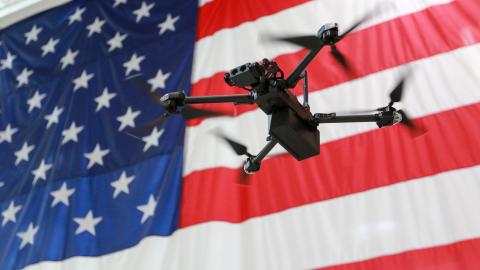Vladimir Putin recently showed off an animated film of Russia attacking the United States while bragging about Russia’s supposed new nuclear missile capabilities. Adding insult to injury, according to him, the new Russian missiles are so complex that the United States can’t defend against them.
Well, not quite. Last weekend Defense Secretary Jim Mattis clarified that the Russian capabilities are years away from being operational. Besides, Russia’s current arsenal can already reach our allies and the U.S. homeland, and it’s not hard to evade a defensive system that isn’t trained on your weapons in the first place. But that could be changing soon, at least to some degree, against some Russian missile threats. Step one is to deploy a serious space sensor layer to provide persistent birth-to-death tracking of missiles, including against the kind that rip through the air at low altitudes 20 times the speed of sound (hypersonics).
Although nerve-rackingly escalatory in the invective directed at the United States, Putin didn’t just start ordering his military to come up with these sophisticated missiles because the Trump administration focused on great power competition in its National Security Strategy, National Defense Strategy and Nuclear Posture Review. Rather, those reports are a response to the behaviors of Russia and China, who are both contesting the United States in various regions of the world. Part of that contest involves building missiles meant to hold at risk U.S. assets that, if targeted, would have strategic effects. The forthcoming Missile Defense Review (MDR) is the next report in the series. (Note the word “ballistic” has been dropped from the report’s name.) I have likened these reports to Russian nesting dolls, each one complementing the other and explaining in greater detail what the United States will do to successfully engage in great power competition.
The MDR ought to, and I expect it to if it remains true to the previous documents, outline how the United States is updating its missile defense policy and architecture to defend the United States and our allies and interests from increasingly complex missile threats from wherever they emanate.
Even after President George Bush rightfully withdrew the United States from the Anti-Ballistic Missile Treaty (ABM) in 2002, U.S. missile defense policy has remained comparatively modest in its aspirations. Policymakers from both parties have eschewed plans to expand missile defense to include capabilities that could defend the United States and allies from Russian or Chinese missile attacks. The current missile defense architecture is designed to defend against simpler (but certainly not “simple”) ballistic missile attacks from rogue nations like North Korea and Iran.
But U.S. military leaders have been not-so-quietly sounding the alarm about the threat to the U.S. homeland posed by Russian cruise missiles. Charles Jacoby, then in charge of Northern Command, warned congressional committees in 2014 of the vulnerability of the United States to the missiles Russia and China are building. The NORTHCOM commander who followed him, Bill Gortney, echoed his sentiments, and in 2015 Sandy Winnefeld, then vice chairman of the Joint Chiefs of Staff, gave a speech outlining the threat of Russian cruise missiles to the United States.
If the United States is really going to “develop a state-of-the-art missile defense system to protect against missile-based attacks from states like Iran and North Korea” as stated in a Trump administration policy document, the United States must shore up weaknesses in the current sensor architecture. That also requires committing the resources necessary to deploy a space-based sensor constellation.
The current U.S. missile defense architecture relies on a combination of terrestrial and sea-based sensors (and a very limited space-based sensor layer) to cue defensive systems. While impressive and effective against many of the ballistic missiles the United States is trained on, the threats emanating from North Korea and Iran, the missile defense systems are only as capable as their sensors. Ground and sea-based systems will always be limited by permanent problems like the curvature of the earth that make difficult persistent tracking from the birth of the missile until intercept.
The vantage point of space, looking down at the earth, deals with that problem handily, and will provide a complement — not a replacement — for the current sensors deployed around the globe. Talk is cheap and the solutions are often expensive, but not as expensive as not doing it. This is the message of Strategic Command’s Gen. John Hyten, who, days before Putin’s brag fest bluntly stated: “There are not enough ships, there are not enough islands in the Pacific that radars can answer all of your sensor questions.”
It’s also way past time to put to rest the notion that when it comes to missile defense, the United States should only worry about North Korea and Iran, or that to counter those “rogue” nations it merely requires a more limited type of defensive system.
Those two countries will continue to advance their missile programs in capability—adding more complex decoys and countermeasures—and quantity, closing the gap for all intents and purposes between the kind of systems needed to optimally discriminate decoys from countermeasures on ballistic missiles and to track the earth-hugging cruise missile variety. “As the countermeasures become more complex that the enemy’s using, you have to see what they’re doing earlier in flight,” Missile Defense Agency Director Lt. Gen. Scott Greaves recently noted. In sum, sensors from space will dramatically supercharge the current ballistic missile defense architecture to stay ahead of the increasing threat even from the rogue nations with smaller ballistic missile arsenals.
Those opposed to qualitatively improving the entire missile defense architecture to include a robust space sensor layer generally make three arguments making the system too robust would be:
* far too expensive;
* too technically difficult;
* and, worst of all, “destabilizing.”
But Gen. Hyten insists that space sensor technology is mature enough to become a reality, and will be far more cost effective than continuing to pepper the globe with terrestrial and sea-based sensors. That will be true, of course, as long as the Pentagon doesn’t “pile on” unreasonable requirements. Gen. Greaves agrees. “We’re not starting from scratch. We’re starting from capability that’s either existing or has developed to a point where there’s high confidence,” he said recently. “It’s based on a design that’s absolutely achievable, Technology Readiness Level Six.” (TL 6 means that the technology has a “fully functional prototype or representational model,” but has not been tested in space.)
If the United States sets out to build a missile defense architecture capable of defending against every missile in adversaries’ arsenals, it would indeed be cost-prohibitive. There are simply too many missiles worldwide. It’s also impossible to imagine a scenario in which the United States remained in a fortress posture and merely played catch with an onslaught of North Korean or Russian missiles. In a real-life scenario, the United States would use a mix of offensive and defensive capabilities, conventional and, perhaps, strategic, to provide optimal protection of key interests, while seeking to end the conflict as quickly as possible on terms most favorable to the United States.
The last criticism, that an improved system would be “destabilizing,” is especially interesting because it has the least evidence to support it. The United States does not build missile defense systems to intercept Russian missiles. Rather than being dissuaded from investing in expensive strategic missiles meant to hold at risk targets in the United States (or invaluable national security satellites) Russia appears to have been tempted to exploit those vulnerabilities. Remaining vulnerable to Russian strategic missiles has not resulted in a more stable environment; in fact, the opposite is true. It’s time the United States close that exploitable gap, and once a satellite constellation is in place, the United States could get even sportier and put a kill capability on those satellites, not only to provide the satellites with a means of self-defense, but also to provide a capability to shoot down threat missiles while they are still boosting.
House Armed Services Committee Chairman Mac Thornberry admonished those who wish to keep the missile defense system intentionally limited in nature. “It is foolish to try and pick and choose what aggression we will stand against and which we will let go unanswered,” he said. “It is not enough to advocate for a more robust cyber response to Russia’s attempts to meddle in our elections but waiver on our response to their renewed nuclear and territorial ambitions.” The chairman is precisely right. Now it’s up to the administration to make the same points just as clearly in the Missile Defense Review, and to provide the necessary funding.

















